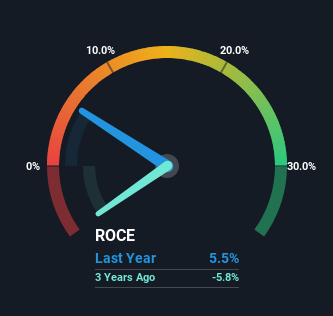- United States
- /
- Renewable Energy
- /
- NYSE:VST
Here's What To Make Of Vistra's (NYSE:VST) Decelerating Rates Of Return
There are a few key trends to look for if we want to identify the next multi-bagger. Ideally, a business will show two trends; firstly a growing return on capital employed (ROCE) and secondly, an increasing amount of capital employed. Ultimately, this demonstrates that it's a business that is reinvesting profits at increasing rates of return. Having said that, from a first glance at Vistra (NYSE:VST) we aren't jumping out of our chairs at how returns are trending, but let's have a deeper look.
What Is Return On Capital Employed (ROCE)?
For those who don't know, ROCE is a measure of a company's yearly pre-tax profit (its return), relative to the capital employed in the business. Analysts use this formula to calculate it for Vistra:
Return on Capital Employed = Earnings Before Interest and Tax (EBIT) ÷ (Total Assets - Current Liabilities)
0.055 = US$1.6b ÷ (US$38b - US$8.8b) (Based on the trailing twelve months to March 2024).
Therefore, Vistra has an ROCE of 5.5%. Even though it's in line with the industry average of 5.5%, it's still a low return by itself.
See our latest analysis for Vistra

Above you can see how the current ROCE for Vistra compares to its prior returns on capital, but there's only so much you can tell from the past. If you're interested, you can view the analysts predictions in our free analyst report for Vistra .
What Can We Tell From Vistra's ROCE Trend?
The returns on capital haven't changed much for Vistra in recent years. Over the past five years, ROCE has remained relatively flat at around 5.5% and the business has deployed 32% more capital into its operations. This poor ROCE doesn't inspire confidence right now, and with the increase in capital employed, it's evident that the business isn't deploying the funds into high return investments.
Another point to note, we noticed the company has increased current liabilities over the last five years. This is intriguing because if current liabilities hadn't increased to 23% of total assets, this reported ROCE would probably be less than5.5% because total capital employed would be higher.The 5.5% ROCE could be even lower if current liabilities weren't 23% of total assets, because the the formula would show a larger base of total capital employed. So while current liabilities isn't high right now, keep an eye out in case it increases further, because this can introduce some elements of risk.
What We Can Learn From Vistra's ROCE
In summary, Vistra has simply been reinvesting capital and generating the same low rate of return as before. Yet to long term shareholders the stock has gifted them an incredible 330% return in the last five years, so the market appears to be rosy about its future. Ultimately, if the underlying trends persist, we wouldn't hold our breath on it being a multi-bagger going forward.
Vistra does have some risks though, and we've spotted 1 warning sign for Vistra that you might be interested in.
While Vistra may not currently earn the highest returns, we've compiled a list of companies that currently earn more than 25% return on equity. Check out this free list here.
New: Manage All Your Stock Portfolios in One Place
We've created the ultimate portfolio companion for stock investors, and it's free.
• Connect an unlimited number of Portfolios and see your total in one currency
• Be alerted to new Warning Signs or Risks via email or mobile
• Track the Fair Value of your stocks
Have feedback on this article? Concerned about the content? Get in touch with us directly. Alternatively, email editorial-team (at) simplywallst.com.
This article by Simply Wall St is general in nature. We provide commentary based on historical data and analyst forecasts only using an unbiased methodology and our articles are not intended to be financial advice. It does not constitute a recommendation to buy or sell any stock, and does not take account of your objectives, or your financial situation. We aim to bring you long-term focused analysis driven by fundamental data. Note that our analysis may not factor in the latest price-sensitive company announcements or qualitative material. Simply Wall St has no position in any stocks mentioned.
About NYSE:VST
Vistra
Operates as an integrated retail electricity and power generation company in the United States.
Solid track record and good value.
Similar Companies
Market Insights
Community Narratives



